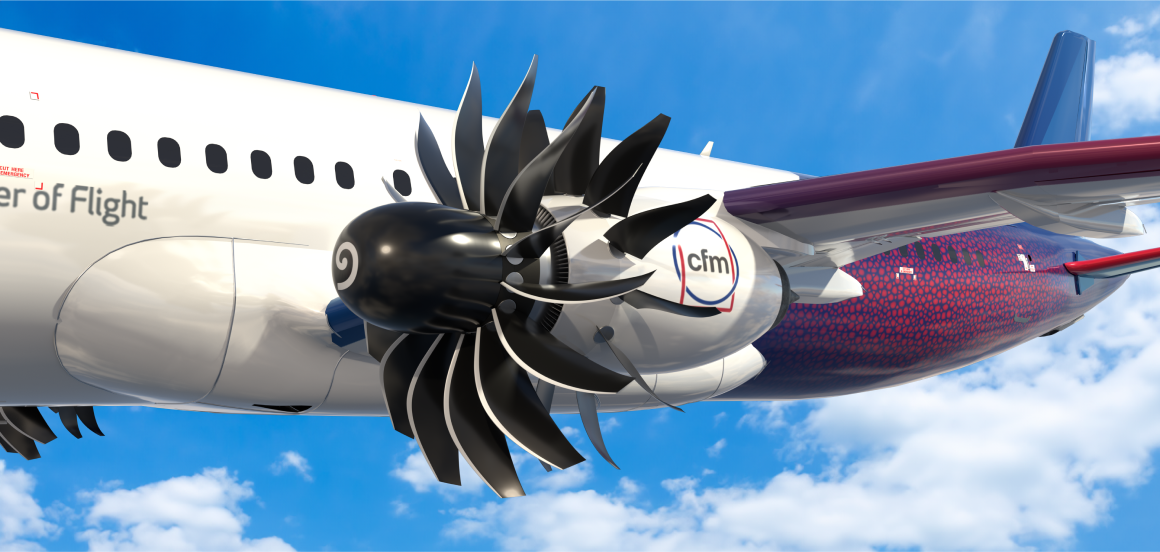Stay Up to Date
Submit your email address to receive the latest industry and Aerospace America news.
Tests are underway on a design that could improve fuel efficiency by 20%
The development of a new single-aisle aircraft is always met with fanfare, particularly if there’s novel technology aboard. For the airliner that Airbus is planning to debut in the 2030s, that tech could be an engine that represents a huge leap forward for air travel.
Turbofans have become the standard in modern aviation due to better fuel efficiency and reduced noise, but open rotor could yield even bigger improvements. In this design, the engine’s larger rotor blades are exposed instead of being contained in a nacelle, which allows more air to flow through the turbine — ultimately reducing the amount of fuel required.
Airbus in March announced plans to assess the feasibility of an open rotor engine (a term the company uses interchangeably with “open fan”) with CFM International, the joint engine venture of French firm Safran and U.S.-based GE Aerospace. GE has been studying open rotor technology since 2021 under its RISE program. To meet Airbus’ late 2030s target for the airliner’s debut, a decision about the engine would need to be made by the end of this decade, when plans call for conducting flight tests with a modified A380 test aircraft.
Why not just continue designing turbofans with bigger blades? The industry might have gone as far as it can in that direction, according to GE’s Mohamed Ali, chief technology and operations officer. He discussed the decision to explore open rotor in March during the Airbus Innovation Summit in Toulouse, France.
While larger and larger fan blades have helped reduce fuel consumption over the years, the duct around a conventional jet engine produces drag that “eats at the benefits that are coming from the fuel burn improvements,” he explained. “And there is a point that is not very far away from where we are today, in which that duct is so big that it wipes out any gains that are coming from making the fan bigger.”
That’s why CFM has turned to open rotor. By shrinking the engine core and constructing larger, composite blades, the engine’s bypass ratio — the amount of air passing through the fan versus through the core of the engine — would increase to 60:1, compared to the 11:1 and 12:1possible with today’s engines. If it works, such a ratio could hand Airbus a decisive advantage in engine performance in the single-aisle market, as well as make CFM the sole engine supplier for this particular aircraft.
But first things first: In the near term, Airbus and its partners must refine the open rotor tech and design to determine if it’s a good match for a passenger airliner — particularly to ensure a safe and relatively quiet experience, Karim Mokaddem, Airbus’ head of research and technology on future aircraft, told me in an interview.
A top priority is “to ensure that we are mastering and reducing the noise that is at the source of the engine, but also the way this noise is transferred into the airplane,” he said. “We are having very good improvements on that.”
CFM has allocated some 2,000 engineers for testing and development on RISE, which is studying various next-generation engine technologies beyond open rotor. So far, some 250 tests have been completed, with wind tunnel tests on subscale engine models ongoing in France and the Netherlands. These are preparation for full-scale ground tests that would be conducted later this decade at GE’s Peebles Test Operation facility in Ohio and in Villaroche, France, validation tests in Victorville, California — and, finally, flight tests in Toulouse with a fully functioning engine aboard the A380 testbed.
Also still to be determined is where exactly these engines would be located on the airframe. Airbus is considering a few placements, from the conventional under-the-wing to the rear of the aircraft over the tail. One big consideration: the engine blades are so large that an under-wing placement would require Airbus to redesign the wings to “gull around the engine,” Mokaddem said.
Airbus is also assessing shielding the area of the fuselage closest to the engines to minimize the risk of a blade off — one or more composite blades breaking, which could dent or puncture the fuselage and, in the worst-case scenario, strike a passenger. Potential solutions under consideration include the additional of material to that section of the aircraft, or constructing it of stronger material.
“Of course, everything additional that you are bringing to the aircraft needs to be compensated by something else to maintain the same performance,” Mokaddem said. So Airbus is running simulations of various scenarios “to ensure that at the end, what you are gaining on one side is not killed by something else.’’
Despite all this activity, he and other executives are keen to emphasize that the open rotor isn’t a done deal. In parallel, Airbus continues to assess alternative engine configurations with its other engine suppliers, Rolls-Royce and Pratt & Whitney. A Rolls-Royce spokesman told me that the company had experimented with open rotor technology years ago but is instead pursuing its UltraFan. Ground testing with the variant of the engine designed for single-aisle jets is slated for 2028. Similarly, Pratt & Whitney said it believes its geared turbofan design remains the right choice for the next Airbus jet.
Boeing did not respond to emailed requests for comment but has previously expressed skepticism about the feasibility of open rotor designs, with Aviation Week reporting last year that the company was leaning more toward a traditional engine for its next single-aisle.
Open rotor designs have been studied on and off since the 1940s for various commercial and NASA research aircraft, but the time might finally be right for the technology to fly aboard a commercial jet, according to long-term analyst Richard Aboulafia. He said that GE appears to have made progress with gears and the use of fixators to make the engine quieter and potentially faster.
“Technologically, the RISE open rotor demonstrator makes the older ones look coal-powered,” he said, referring to the subscale models in testing. “There’s all kinds of improvements baked into this technological approach.”
For airline customers, the choice between Airbus versus Boeing aircraft often comes down to innovations like fly-by-wire and potential engine efficiency improvements, so the decisions each company makes for their next single-aisles could influence air travel for decades to come — as well as the industry’s ongoing quest to reduce its carbon emissions.
But for now, Airbus appears to be in a strong position. “This is a company that’s overwhelmingly successful, so it’s not like they lack the revenue and it could serve to cement their very strong market position for lifetimes,” said Aboulafia.
About Charlotte Ryan
A London-based freelance journalist, Charlotte previously covered the aerospace industry for Bloomberg News.
Related Posts
Stay Up to Date
Submit your email address to receive the latest industry and Aerospace America news.




